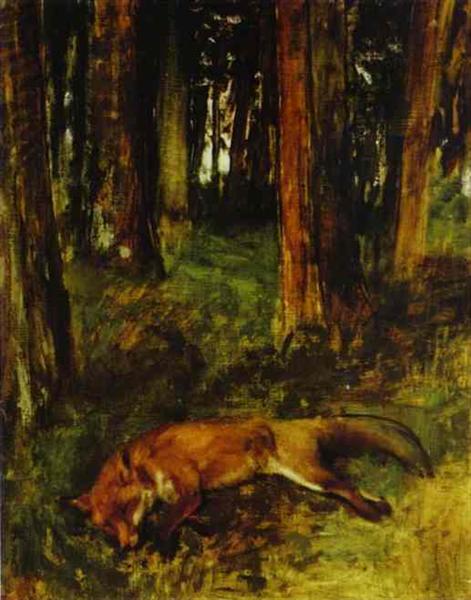Descrizione
Edgar Degas's Dead Fox Lying in the Undergrowth (1865) stands as a fascinating example of his exploration of realism and capture of the nature of his time. In this painting, Degas moves away from his best-known themes of dance and urban life to present an intimate and contemplative composition that invites the viewer to reflect on nature and mortality.
At the heart of the work is the dead fox, whose figure lies resting on a bed of dense vegetation. The composition is carefully structured, with the fox positioned slightly off-centre, drawing attention to the surrounding environment. The undergrowth, rich in shades of greens, browns and yellows, is painted in a loose and vibrant technique, capturing the essence of the wild environment. The texture of the undergrowth provides a striking contrast to the fox’s fur, which has a warm, earthy tone, hinting at the life that had existed before its death.
Degas, renowned for his ability to capture human movement and emotion, offers an almost static depiction in this work, causing the viewer to contemplate the stillness of the moment. The choice of such an unusual subject, a deceased animal in a natural landscape, shows a depth of interest in the reality surrounding animal life, a relatively unexplored theme in his career. This could be interpreted as an echo of the changing perception of nature in 19th-century art, where death and life coexist in a ceaseless dance.
The handling of color is one of the most outstanding aspects of this painting. Degas uses a palette that oscillates between somber and vibrant tones, specifically in the greens of the undergrowth that are fresh and full of life, contrasting with the pale and dull gray of the fox. This combination not only accentuates the figure of the animal, but also suggests its listlessness and the inevitable cycle of life and death. Shadows are skillfully employed to create a sense of depth and volume, in a palpable desire by Degas to capture the three-dimensionality of space.
It is important to mention that “Dead Fox Lying in the Undergrowth” is a work that fluctuates between still life and wildlife portraiture, a category that Degas had already begun to explore, but which in this work becomes a meditation on existence itself. This particular composition embodies a solidarity with the natural environment and reflects what some critics consider to be the beginning of a dialogue towards Impressionism, although it is still very much rooted in an academic realism.
It is worth noting that Degas experimented with various techniques throughout his career, and although he is primarily known for his work in pastels and his photographic approach to painting, “Dead Fox Lying in the Undergrowth” is also characterized by the implementation of a loose brushstroke that anticipates the evolution of art towards Impressionism. This work, although less recognized compared to his ballets and scenes of daily life, is fundamental to the understanding of his artistic evolution and his relationship with nature.
In conclusion, Edgar Degas's "Dead Fox Lying in the Undergrowth" is a work that not only moves us with its honest representation of death and life in the natural environment, but also symbolizes a moment in Degas' career where he allows himself to explore new themes and techniques. Thus, this painting becomes a reflection on the vulnerability of existence, all framed in the technical mastery that defines the artist, making this piece a jewel in his corpus.
KUADROS ©, a famous painting on your wall.
Hand-made oil painting reproductions, with the quality of professional artists and the distinctive seal of KUADROS ©.
Painting reproduction service with satisfaction guarantee. If you are not completely satisfied with the replica of your painting, we will refund 100% of your money.

